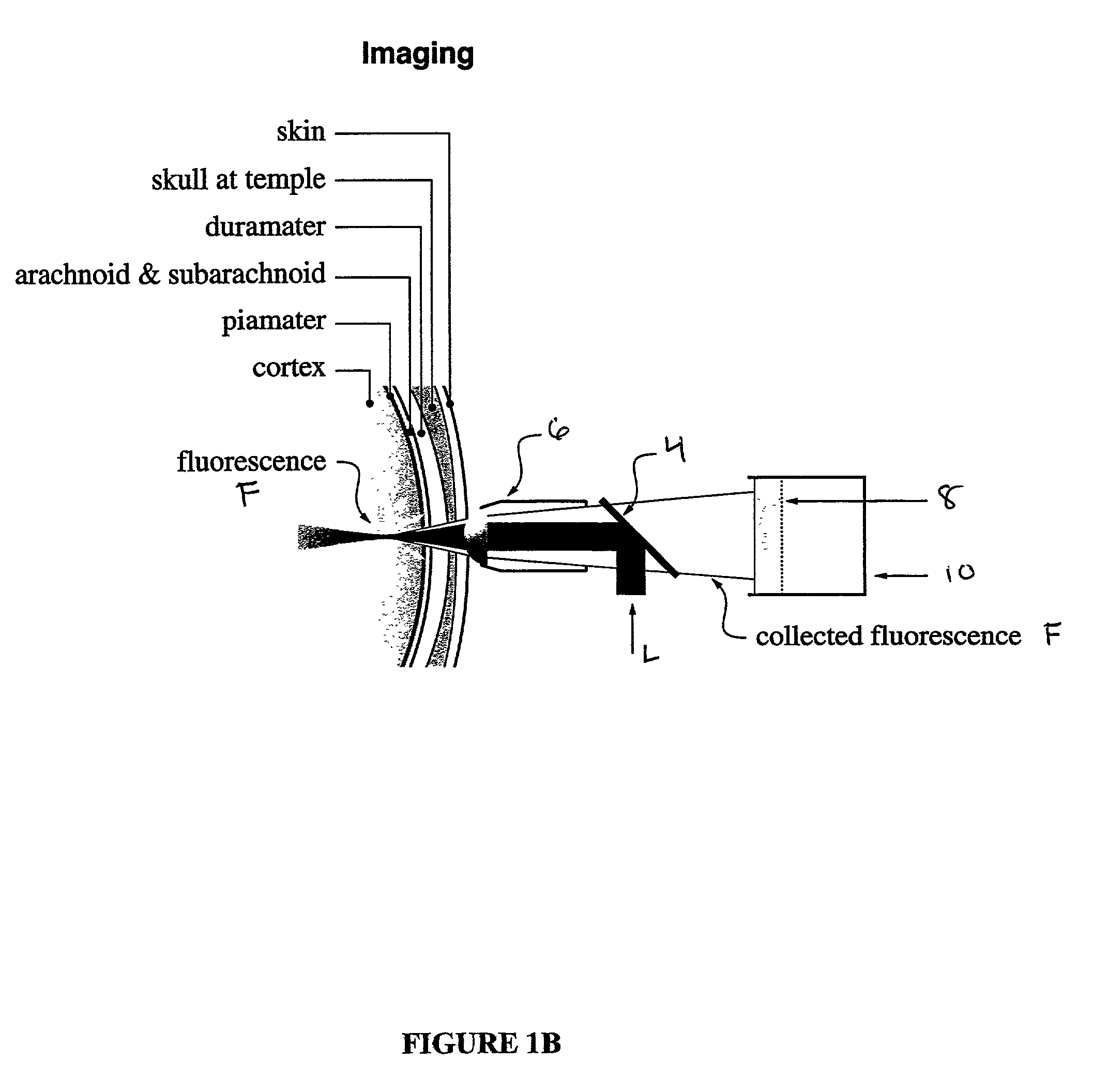In vivo multiphoton diagnostic detection and imaging of a neurodegenerative disease
a neurodegenerative disease and multi-photon imaging technology, applied in the field of in vivo multi-photon diagnostic detection and imaging of neurodegenerative diseases, can solve the problems of untold anguish for millions, and amnesia accompanied by frustration and paranoia, and achieve the effect of promoting simultaneous multi-photon excitation of brain tissu
- Summary
- Abstract
- Description
- Claims
- Application Information
AI Technical Summary
Benefits of technology
Problems solved by technology
Method used
Image
Examples
example 1
In vivo Imaging of Amyloid Deposition
[0064]Nine male Tg2576 mice (mean age 18.6 months (Hsiao, et al., “Correlative Memory Deficits, Aβ Elevation, and Amyloid Plaques in Transgenic Mice,”Science, 274:99-102 (1996), which is hereby incorporated by reference in its entirety), were used for the in vivo imaging of plaques. These mice express human amyloid precursor precursor carrying the Swedish mutation under the hamster prion protein promoter. The skull was prepared 2-6 days prior to imaging. Mice were anesthetized with Avertin (Tribromoethanol, 250 mg / kg IP). A high-speed drill (Fine Science Tools, Foster City Calif.) was used to thin the skull in a circular region, approximately 1-1.2 mm in diameter (FIG. 2A), using a dissecting microscope for gross visualization of the site. Heat and vibration artifacts were minimized during drilling by frequent application of artificial cerebrospinal fluid (“ACSF”; 125 mM NaCl; 26 mM NaHCO3; 1.25 mM NaH2PO4; 2.5 mM KCl; 1 mM MgCl2; 1 mM CaCl2; 25 ...
example 2
[0066]Montages were reconstructed into a single stack of images using Scion Image (Scion Corp, Frederick Md.). The area of individual plaque cross-sections was measured in each optical section by thresholding at two standard deviations above the mean of an adjacent background region. Plaques that did not satisfy criteria of imaging were eliminated from the measurement set. Plaques on the edge of the imaging area or on one of the montage lines were rejected due to the potential imprecision of moving the animal on the stage. Plaques whose intensity was not sufficiently above background for appropriate thresholding were also eliminated. This rejected many plaques, typically deep in the preparation, that appeared to be present, but were too faint to measure using the automatic threshold technique. Finally, plaques whose images contained any appreciable motion artifact were rejected. Maximal plaque diameter was then calculated from the cross-section of largest area for each...
example 3
[0067]The tail of the animal was warmed on a heating pad to dilate the blood vessels, and approximately 0.05 ml fluorescein (25 mg / ml) in sterile PBS was injected into a tail vein of the mouse at least 20 minutes prior to imaging. The dye did not cross the blood-brain barrier and permitted concurrent visualization of blood vessels throughout the imaging volume in the brain.
PUM
| Property | Measurement | Unit |
|---|---|---|
| wavelength | aaaaa | aaaaa |
| distance | aaaaa | aaaaa |
| distance | aaaaa | aaaaa |
Abstract
Description
Claims
Application Information
 Login to View More
Login to View More - R&D
- Intellectual Property
- Life Sciences
- Materials
- Tech Scout
- Unparalleled Data Quality
- Higher Quality Content
- 60% Fewer Hallucinations
Browse by: Latest US Patents, China's latest patents, Technical Efficacy Thesaurus, Application Domain, Technology Topic, Popular Technical Reports.
© 2025 PatSnap. All rights reserved.Legal|Privacy policy|Modern Slavery Act Transparency Statement|Sitemap|About US| Contact US: help@patsnap.com



